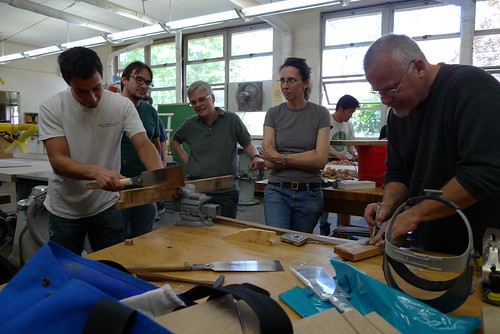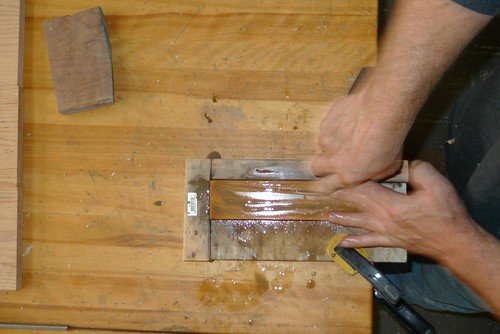This post is a little off-subject, but since readership is down at this point I'm going to publish it anyway. For anyone who's interested in combining woodworking with bronze casting, I wanted to share the results of using a wood model as a starting point for a casting. (I've been taking Metal Sculpture 169 this term along with our wood class.)
Wax is the traditional material used to create models for casting, but it's also possible to use organic materials such as branches, or synthetic materials like plexiglass. The key is that whatever material you use must 'burn out': the model or 'positive' is encased in a plaster and sand mold, then placed in a kiln for several days at high temperature. While it bakes in the kiln the wax or other source material burns away and leaves a cavity in the shape of your original model. Then molten bronze is poured into the mold to fill the cavity and recreate the original form.
The wood class must have been influencing me because I liked the idea of reproducing in bronze the clean lines, angles, and facets you can achieve with wood, as well as having more control over actually assembling a model or form. (With wax, it can be difficult to 'glue' separate pieces together without bending or deforming some of the components, especially if you are trying to maintain straight lines, sharp edges, etc.
I got different opinions about whether the wood would burn out thoroughly when baked in the kiln. Any charcoal remnants inside the mold would not mingle well with the bronze and would produce an incomplete casting. The type of wood was important: poplar (which I used) was a better bet than a harder, denser wood like oak.
I built the model below using the straight poplar rods you can buy at OSH or other stores in 36" lengths, which come in different widths (1/4", 1/2", 1", etc.). I cut these at various angles using the band saw and miter guide in the wood shop, then sanded them on the rotary sander. (This was back when there was still time to do extra work in the shop.)

Below is the model after gating, which creates the channels through which the molten bronze will flow into the cavity inside the mold that is created during burn-out. Gating a wooden model turns out to be similar to gating a wax model: you can melt and attach the wax tubes directly to the wood surfaces. Gates also provide pathways for the burn-out ash to escape the mold after it's been baked in the kiln. In my case it was important to have a lot of gating (even for a relatively small model), because the wood ash was considered more problematic to evacuate from the mold than wax would be.

Skipping ahead to post-kiln baking and 'pour', the results were pretty good. The wood burned out completely, and there was little 'porosity' in the resulting bronze surfaces, which means the bronze completely filled the cavity left in the mold. There was quite a bit of 'flashing', which is the lacy extrusion of the bronze that extends out from corners and edges of the model, but that's pretty typical even for wax models. Here's the casting out of the mold:

Here it is after 'chasing' (removing the gates, then grinding and polishing the surface), and then again with a basic brown patina applied:


This was a fairly simple model - my goal was to move on to something more complex, but just didn't have time this term - I'm hoping to revisit the process later. I like the idea that you can use the wood as a starting point, because it opens up an abstract and geometric element to the bronze which could be interesting. Didn't get to any of these ideas:



Carving or chiseling the wood would give you other possibilities. Another idea would be to build a wood model, make a rubber mold of it, create a wax version of the model, and cast that. The advantage would be you'd retain the clean lines and sharp edges of the original wood, which could be hard to create from scratch with the wax. You'd also end up with a lighter casting - my small bronze, which is only about 4"x5"x5", is
heavy (about six pounds). And bronze is expensive - costs about $5.50 a pound. So the one thing I wish I'd done before casting mine is to drill out the legs with a Forstner bit. Or maybe a chisel... or an Oliver mortising machine... endless possibilities.
p.s. If you're interested in bronze casting there are at least two classes this fall at the foundry, and they need enrollment to keep the facility going.

































